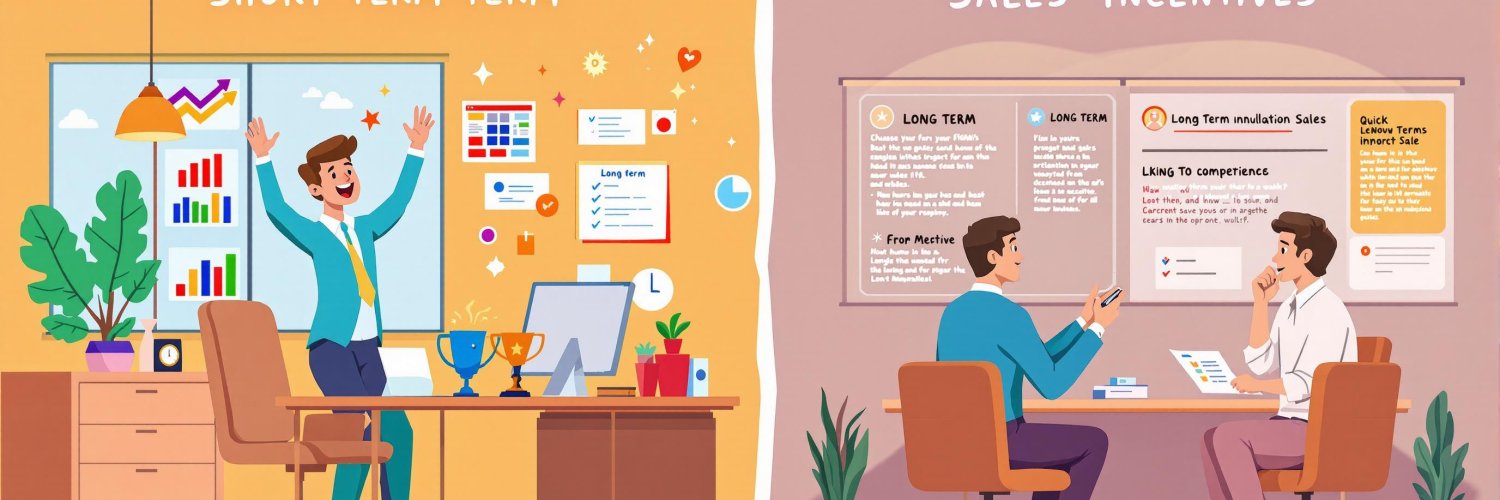Sales incentives drive performance by rewarding achievements with cash bonuses, stock options, or perks. They can be short-term (quick wins) or long-term (sustained growth). Here’s what you need to know:
- Short-Term Incentives: Focus on immediate goals (e.g., monthly sales or hitting quotas). Rewards include cash bonuses, gift cards, or competitions. Great for quick motivation but may lead to short-term focus.
- Long-Term Incentives: Aim for sustained success (e.g., yearly revenue growth or retention). Rewards include stock options, profit-sharing, or career development. Effective for retention but harder to implement.
- Hybrid Approach: Combines both for balance. Example: Monthly bonuses + annual equity grants.
Quick Comparison
| Aspect | Short-Term Incentives | Long-Term Incentives |
|---|---|---|
| Time Frame | Immediate to 3 months | 6 months to several years |
| Goals | Quick wins, hitting quotas | Sustained growth, retention |
| Rewards | Cash, prizes, gift cards | Equity, profit-sharing, promotions |
| Focus | Individual performance | Team and company success |
| Payment Frequency | Monthly or quarterly | Annually or milestone-based |
Key takeaway: Use short-term incentives to boost immediate results and long-term rewards to build loyalty and growth. A mix of both ensures a motivated and aligned sales team.
What is a Long-Term Incentive Plan (LTIP) and How Does It Work?
Quick-Win Sales Incentives
Common Quick Rewards
Sales teams often use short-term incentives to boost performance. Here are some popular options:
- Cash Bonuses: These are monetary rewards given for achieving specific targets, typically on a monthly or quarterly basis. Examples include spot bonuses for closing major deals or commission accelerators tied to sales performance.
- SPIFs (Sales Performance Incentive Funds): These bonuses are offered for selling specific products or services, making them great for promoting new launches or clearing out inventory.
- Team Competitions: Short contests that encourage friendly rivalry while focusing on goals like generating the most new leads, achieving high conversion rates, increasing upsell revenue, or improving customer satisfaction scores.
- Non-Monetary Rewards: These include recognition programs, extra paid time off, or exclusive experiences to reward exceptional performance and provide immediate gratification. You can also award curated corporate gift collections to celebrate contest winners, recognize milestones, or thank clients—keeping incentives memorable and on-brand without relying solely on cash.
While these rewards can yield quick results, they come with some trade-offs which can be more easily managed and streamlined using employee recognition software.
Quick Rewards: Pros and Cons
Short-term incentives can be powerful, but they’re not without challenges. Here’s a breakdown:
| Aspect | Advantages | Limitations |
|---|---|---|
| Motivation | Boosts immediate performance | Can lead to short-term focus |
| Implementation | Simple to launch and adjust | Needs constant monitoring |
| Cost Control | Spending is performance-based | May strain cash flow during peaks |
| Team Dynamic | Builds energy and excitement | Risk of unhealthy competition |
| Results | Drives quick metric improvements | May not align with long-term goals |
Understanding these factors is key to designing effective incentive programs.
Setting Up Quick Incentives
To create impactful short-term incentive programs, follow these steps:
- Data-Driven Setup: Use your CRM to establish performance baselines. Research shows only 50% of sales teams currently rely on data for accurate forecasting.
- Clear Goals and Metrics: Define specific, measurable objectives that align with your business strategy. For example, Krish Sivanathan, Director of Operations at Packagecloud, shares:
“Utilizing sales insights we have been able to conduct targeted experiments, enabling Packagecloud to increase engagement rates by 18% through the refinement of scripts and lead targeting.”
- Real-Time Tracking: Implement dashboards that provide instant updates on performance metrics. Modern CRM tools can deliver a return of over $8 for every $1 spent.
- Regular Assessment: Continuously evaluate metrics like conversion rates, revenue growth, engagement, and customer satisfaction.
When integrated with existing sales processes, quick-win incentives can make a noticeable difference. For instance, Baremetrics saw impressive results:
“With in depth insights and metrics, Teamgate truely is the only CRM designed specifically for SaaS teams. We were up and running within days and immediately increased productivity and efficiency of our sales teams resulting in a 132% increase in conversion rates!”
– Allison Barkley, Director of Operations, Baremetrics
Now, let’s look at how extended incentives can drive sustained growth.
Extended Sales Incentives
Common Extended Rewards
Long-term incentives are a powerful way to boost growth and keep employees engaged. Here are some popular reward structures:
- Annual Performance Bonuses: These are rewards tied to performance metrics tracked over a full year. They often combine individual sales achievements, team goals, and company-wide objectives.
- Equity-Based Programs: Stock options and restricted stock units (RSUs) align sales reps’ goals with the company’s success. For example, many tech companies offer equity packages that vest over several years, with portions becoming available annually.
- Career Development Plans: Companies that care about their sales teams’ futures often provide:
- Advanced training programs
- Leadership opportunities
- Reimbursement for certifications
- Mentorship programs
- Tiered Commission Structures: These multi-year plans reward consistent performance and loyalty. For instance, commission rates might increase over time as a way to acknowledge ongoing success.
Extended Rewards: Pros and Cons
| Aspect | Benefits | Challenges |
|---|---|---|
| Employee Retention | Builds loyalty and lowers turnover | Requires careful financial planning |
| Performance Impact | Encourages strategic thinking and relationships | Results may take longer to show |
| Team Culture | Supports collaboration over competition | May not address short-term motivation |
| Business Growth | Aligns with long-term company goals | Can be difficult to design and implement |
| Risk Management | Provides more predictable costs | Needs constant monitoring and fine-tuning |
Understanding these pros and cons can help you create a well-rounded incentive program.
Setting Up Extended Incentives
Here’s how to design an effective long-term incentive plan:
- Define clear criteria for growth and rewards. Use tools like your CRM to track key performance indicators (KPIs) such as customer lifetime value, retention rates, pipeline velocity, and deal growth.
- Balance individual and team rewards. A points-based system can combine metrics like personal sales, team contributions, and customer satisfaction.
- Regularly review and adjust. Track key metrics, gather feedback from participants, and tweak the program to keep it relevant.
- Leverage CRM tools for automated tracking, real-time dashboards, and analytics to ensure your rewards are always optimized.
A well-structured incentive program can keep your team motivated and aligned with long-term goals.
sbb-itb-5772723
Combining Short and Long-Term Rewards
Building a Complete Incentive Plan
Creating a successful incentive program means finding the right balance between short-term motivation and long-term commitment. A strong plan should include quick rewards to keep energy high and long-term benefits to maintain focus on bigger goals.
Here’s how companies often structure these hybrid plans:
1. Set Clear Performance Tiers
Define performance levels that include monthly, quarterly, and annual goals. For instance, sales teams might earn:
- Monthly bonuses for meeting quotas (e.g., $500–$2,000)
- Quarterly team rewards for increasing pipeline growth
- Annual equity grants tied to customer retention
2. Align Metrics for Balance
Ensure short-term and long-term goals work together, not against each other. Focus on metrics like:
- Daily/weekly activities (e.g., calls, meetings)
- Monthly revenue achievements
- Quarterly customer satisfaction scores
- Yearly customer lifetime value improvements
3. Diversify Reward Types
Combine immediate payouts with future-focused incentives:
- Instant commissions
- Quarterly performance bonuses
- Annual profit-sharing
- Equity with multi-year vesting schedules
Tailor these rewards to specific sales roles to make sure every team member stays motivated.
Matching Rewards to Sales Roles
Different sales roles need different types of incentives. Here’s a breakdown of how to match rewards to the responsibilities of each position:
| Role | Short-Term Incentives | Long-Term Incentives |
|---|---|---|
| SDRs/BDRs | Activity-based bonuses (daily/weekly), Monthly qualified lead goals | Quarterly bonuses, Career growth opportunities |
| Account Executives | Monthly sales commissions, Deal closure bonuses | Annual revenue goals, Equity packages |
| Account Managers | Quarterly retention bonuses, Upsell incentives | Recurring revenue growth, Long-term client rewards |
| Sales Leaders | Team performance bonuses | Multi-year growth targets, Leadership development |
Tools for Managing Incentives
Managing a mix of short- and long-term rewards requires the right tools. Modern CRM platforms can simplify tracking and calculations, making them essential for managing complex incentive plans.
Key CRM features to look for:
- Real-Time Performance Tracking: Monitor progress on both short- and long-term goals.
- Automated Commission Calculations: Eliminate errors and save time when distributing rewards.
- Custom Dashboards: Create role-specific views to track relevant metrics.
- Advanced Analytics: Evaluate how effective your incentive program is.
Investing in a CRM system pays off – companies often see an $8 return for every $1 spent. If your goal is to optimize sales incentives, a robust CRM tool is a must-have.
Tracking Incentive Results
Key Success Metrics
To achieve both immediate results and sustained growth, it’s essential to track performance across several areas. Here’s a breakdown of important metrics to monitor:
| Metric Category | Short-Term Indicators | Long-Term Indicators |
|---|---|---|
| Revenue Performance | Monthly sales totals, deal closure rates | Annual revenue growth, customer lifetime value |
| Team Efficiency | Daily/weekly task completion, response time | Pipeline velocity, average sales cycle length |
| Customer Success | Initial deal size, first-month retention | Customer churn rate, net revenue retention |
| ROI Measures | Cost per acquisition, immediate commission payout | Total program ROI, team retention rates |
For SaaS businesses focusing on SMBs, customer retention is particularly critical. The average yearly churn rate for SaaS companies exceeds 58%. This highlights the importance of crafting incentives that encourage ongoing customer engagement and satisfaction.
Now, let’s explore how to track these metrics and fine-tune your incentive strategies.
Monitoring and Improving Programs
Using these metrics as a foundation, real-time tracking and regular analysis are key to refining your incentive plans. Modern CRM tools can play a big role in helping you keep tabs on performance and make informed adjustments.
“Utilizing sales insights we have been able to conduct targeted experiments, enabling Packagecloud to increase engagement rates by 18% through the refinement of scripts and lead targeting.” – Krish Sivanathan, Director of Operations, Packagecloud
Here’s how to ensure your incentive programs stay effective:
- Use Real-Time Tracking
- Set up automated dashboards to display daily, weekly, and monthly progress.
- Track both activity-based and outcome-based metrics for individuals and teams.
- Monitor how performance aligns with set goals.
- Analyze Data Regularly
- Review monthly performance data to identify patterns and trends.
- Compare results across various incentive structures to see what works best.
- Evaluate how incentives are influencing key outcomes.
- Make Data-Driven Adjustments
- Adjust reward levels based on performance data.
- Update and refine metrics on a quarterly basis.
- Experiment with new incentive combinations in controlled settings to see their impact.
Next Steps
Main Points Summary
Incentives play a crucial role in driving both short-term results and long-term growth. The trick is to strike a balance between rewards that deliver immediate results and those that encourage consistent, ongoing performance.
| Incentive Type | Ideal For | Outcome |
|---|---|---|
| Short-Term | Boosting immediate revenue and hitting campaign goals | Delivers quick results |
| Long-Term | Retaining customers and ensuring steady growth | Supports continuous improvement |
| Hybrid Approach | Merging short- and long-term benefits | Can lead to major conversion gains (e.g., a 132% increase) |
These insights can help you fine-tune your incentive strategy for better results.
Getting Started
It’s time to put these strategies into action to strengthen your sales efforts. Start by analyzing your current sales processes to identify areas where quick wins and long-term growth opportunities exist. A dedicated CRM platform, like Teamgate CRM, can help you organize and track your incentive programs effectively.
Teamgate CRM is known for its quick onboarding and practical tools. As Krish Sivanathan, Director of Operations at Packagecloud, shared:
“Utilizing sales insights we have been able to conduct targeted experiments, enabling Packagecloud to increase engagement rates by 18% through the refinement of scripts and lead targeting.”
Begin with a straightforward incentive structure and expand it as you gather insights. Leverage your CRM’s analytics to monitor progress and fine-tune your approach as needed.





